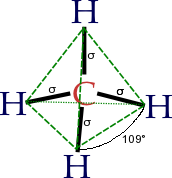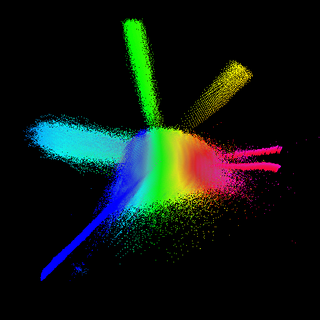
Chemistry is the scientific discipline involved with elements and compounds composed of atoms, molecules and ions: their composition, structure, properties, behavior and the changes they undergo during a reaction with other substances.
The following outline is provided as an overview of and topical guide to chemistry:

In chemistry, organic compounds are generally any chemical compounds that contain carbon-hydrogen bonds. Due to carbon's ability to catenate, millions of organic compounds are known. The study of the properties, reactions, and syntheses of organic compounds comprises the discipline known as organic chemistry. For historical reasons, a few classes of carbon-containing compounds, along with a handful of other exceptions, are not classified as organic compounds and are considered inorganic. Other than those just named, little consensus exists among chemists on precisely which carbon-containing compounds are excluded, making any rigorous definition of an organic compound elusive.

Organic chemistry is a branch of chemistry that studies the structure, properties and reactions of organic compounds, which contain carbon in covalent bonding. Study of structure determines their chemical composition and formula. Study of properties includes physical and chemical properties, and evaluation of chemical reactivity to understand their behavior. The study of organic reactions includes the chemical synthesis of natural products, drugs, and polymers, and study of individual organic molecules in the laboratory and via theoretical study.
Physical science is a branch of natural science that studies non-living systems, in contrast to life science. It in turn has many branches, each referred to as a "physical science", together called the "physical sciences".
A CAS Registry Number, also referred to as CASRN or CAS Number, is a unique numerical identifier assigned by the Chemical Abstracts Service (CAS) to every chemical substance described in the open scientific literature, including organic and inorganic compounds, minerals, isotopes, alloys and nonstructurable materials. CASRNs are generally serial numbers, so they do not contain any information about the structures themselves the way SMILES and InChI strings do.

Chemical Abstracts Service (CAS) is a division of the American Chemical Society. It is a source of chemical information. CAS is located in Columbus, Ohio, United States.

Chemical space is a concept in cheminformatics referring to the property space spanned by all possible molecules and chemical compounds adhering to a given set of construction principles and boundary conditions. It contains millions of compounds which are readily accessible and available to researchers. It is a library used in the method of molecular docking.
The Beilstein database is the largest database in the field of organic chemistry, in which compounds are uniquely identified by their Beilstein Registry Number. The database covers the scientific literature from 1771 to the present and contains experimentally validated information on millions of chemical reactions and substances from original scientific publications. The electronic database was created from Beilstein's Handbook of Organic Chemistry, founded by Friedrich Konrad Beilstein in 1881, but has appeared online under a number of different names, including Crossfire Beilstein. Since 2009, the content has been maintained and distributed by Elsevier Information Systems in Frankfurt under the product name "Reaxys".
PubChem is a database of chemical molecules and their activities against biological assays. The system is maintained by the National Center for Biotechnology Information (NCBI), a component of the National Library of Medicine, which is part of the United States National Institutes of Health (NIH). PubChem can be accessed for free through a web user interface. Millions of compound structures and descriptive datasets can be freely downloaded via FTP. PubChem contains multiple substance descriptions and small molecules with fewer than 100 atoms and 1000 bonds. More than 80 database vendors contribute to the growing PubChem database.
Organosilicon compounds are organometallic compounds containing carbon–silicon bonds. Organosilicon chemistry is the corresponding science of their preparation and properties. Most organosilicon compounds are similar to the ordinary organic compounds, being colourless, flammable, hydrophobic, and stable to air. Silicon carbide is an inorganic compound.

A chemical substance is a form of matter having constant chemical composition and characteristic properties. Some references add that chemical substance cannot be separated into its constituent elements by physical separation methods, i.e., without breaking chemical bonds. Chemical substances can be simple substances, chemical compounds, or alloys. Chemical elements may or may not be included in the definition, depending on expert viewpoint.

ChemSpider is a database of chemicals. ChemSpider is owned by the Royal Society of Chemistry.

ChemPhysChem is a peer-reviewed scientific journal published by Wiley-VCH on behalf of Chemistry Europe and is a sister publication to other scientific journals published by Wiley-VCH, including Angewandte Chemie and Chemistry—A European Journal. It was established in 2000 and covers all primary and secondary topics in chemical physics and physical chemistry. Initially published monthly, the journal move to 18 issues per year in 2007, and further to biweekly in 2016.
VINITI Database RAS is a database provided by the All-Russian Institute for Scientific and Technical Information (VINITI). The database is devoted to scientific publications. It is described as a large abstracting database. In general, it is indexed for the natural sciences, exact sciences, and technical sciences. Included in this database is AJ, indexed from 1981 to the present day.
Reaxys is a web-based tool for the retrieval of chemistry information and data from published literature, including journals and patents. The information includes chemical compounds, chemical reactions, chemical properties, related bibliographic data, substance data with synthesis planning information, as well as experimental procedures from selected journals and patents. It is licensed by Elsevier.
Chemisches Zentralblatt is the first and oldest abstracts journal published in the field of chemistry. It covers the chemical literature from 1830 to 1969 and describes therefore the "birth" of chemistry as science, in contrast to alchemy. The information contained in this German journal is comparable with the content of the leading source of chemical information Chemical Abstracts Service (CAS), which started publishing abstracts in English in 1907.
The Journal of Biomedical Materials Research is a peer-reviewed scientific journals of biomedical material science. It was established in 1967. In 1974, it absorbed Biomedical Materials Symposium (1971–1974). In 1990, it absorbed the journal Journal of Applied Biomaterials (1990–1995). In 2002, it split into two parts, Journal of Biomedical Materials Research Part A, and Journal of Biomedical Materials Research Part B. The two parts are published by John Wiley & Sons.